Many phenomena in various science fields are mathematically expressed by using the well-known evolution equations. The diffusion equation is one of them, and mathematically corresponds to the Markov process in relation to the normal distribution rule.
A. Standard diffusion equation
Standard diffusion equation is a simplistic second order partial differential equation written as:
\[
\begin{equation}
\frac{\partial \rho(x, t)}{\partial t}
= D \frac{\partial^2 \rho(x, t)}{\partial x^2}
\end{equation}
\]
A1. Finite difference method for time and space
Finite difference of time:
\begin{equation}
\frac{\partial\rho}{\partial t} (x_i,t_j) = \frac{\rho(x_i, t_j + \Delta t) - \rho(x_i, t_j)}{\Delta t} + \mathcal{O}(\Delta t)
\end{equation}
Finite difference of space:
\[
\begin{equation}
\frac{\partial^2\rho}{\partial x^2} (x_i,t_j) = \frac{\rho(x_i+\Delta x,t_j) - 2\rho(x_i,t_j) + \rho(x_i-\Delta x,t_j)}{dx^2} + \mathcal{O}(\Delta x^2)
\end{equation}
\]
A2. Explicit scheme (forward time)
Apply equation(2) and (3) to equation(1), and let \(\rho_{i,j} = \rho(x_i,t_j)\), we get the expression of forward time evolution
\[
\begin{align}
&\ \frac{\rho_{i,j+1} - \rho_{i,j}}{\Delta t} = D \frac{\rho_{i+1,j} - 2\rho_{i,j} + \rho_{i-1,j}}{\Delta x^2} \\
&\Rightarrow \rho_{i,j+1} = (1 - 2\lambda) \rho_{i,j} + \lambda (\rho_{i+1,j} + \rho_{i-1, j})
\end{align}
\]
where \[\lambda=\frac{D \cdot \Delta t}{\Delta x^2}\].
Rewrite this in matrix form,
\[
\begin{equation}
\vec{\rho}_{i, j+1} = A \vec{\rho}_{i, j} + R(\text{accounts for boundary conditions})
\end{equation}
\]
Supplemented by initial condition: \( \rho_{i,0} = \rho(x_i)\),
and Boundary conditions: \( \rho_{0,j} = \rho_0\), \( \rho_{m,j} = \rho_m\), we can solve it like this:

*Sovling an example system with initial value of \(\rho_{center}=1.0\) at center and boundary conditions with \(\rho_L = \rho_R = 0\).

A3. Implicit scheme (backward time)
In implicit scheme, time evolves backwards.
\[
\begin{align}
&\ \frac{\rho_{i,j} - \rho_{i,j-1}}{\Delta t} = D \frac{\rho_{i+1,j} - 2\rho_{i,j} + \rho_{i-1,j}}{\Delta x^2} \\
&\Rightarrow (1 + 2\lambda) \rho_{i,j} - \lambda (\rho_{i+1,j} + \rho_{i-1, j}) = \rho_{i,j-1}
\end{align}
\]
where \[\lambda=\frac{D \cdot \Delta t}{\Delta x^2}.\]
Rewrite this in matrix form,
\[
\begin{equation}
A \vec{\rho}_{i, j} - R = \vec{\rho}_{i, j - 1}
\end{equation}
\]
Supplemented by initial condition: \( \rho_{i,0} = \rho(x_i)\),
and Boundary conditions: \( \rho_{0,j} = \rho_0\), \( \rho_{m,j} = \rho_m\), we can solve it like this:

*Sovling an example system with initial value of \(\rho_{center}=1.0\) at center and boundary conditions with \(\rho_L = \rho_R = 0\).
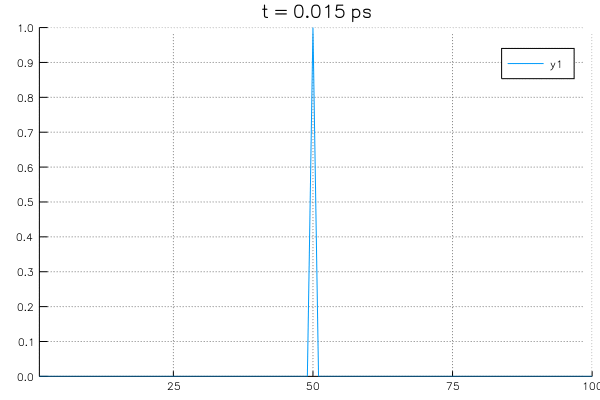
A4. Crank-Nicolson scheme
In Crank-Nicolson scheme, we take the average of explicit scheme and implicit scheme.
\[
\begin{align}
&\ \frac{\rho_{i,j + 1} - \rho_{i,j}}{\Delta t} = \frac{D}{2} ( \frac{\rho_{i+1,j} - 2\rho_{i,j} + \rho_{i-1,j}}{\Delta x^2} + \frac{\rho_{i + 1,j + 1} - 2\rho_{i,j + 1} + \rho_{i - 1,j + 1}}{\Delta x^2} ) \\
&\Rightarrow (2 + 2\lambda) \rho_{i,j + 1} - \lambda (\rho_{i+1,j + 1} + \rho_{i-1, j + 1}) = (2 - 2\lambda) \rho_{i,j} + \lambda (\rho_{i+1,j} + \rho_{i-1, j})
\end{align}
\]
where \[\lambda=\frac{D \cdot \Delta t}{\Delta x^2}\].
Rewrite this in matrix form,
\[
\begin{equation}
A \vec{\rho}_{i, j + 1} - R = B \vec{\rho}_{i, j} + R
\end{equation}
\]
Supplemented by initial condition: \( \rho_{i,0} = \rho(x_i)\),
and Boundary conditions: \( \rho_{0,j} = \rho_0\), \( \rho_{m,j} = \rho_m\), we can solve it like this:

Solvlng an example system with initial value of \(\rho_{center}=1.0\) at center and boundary conditions with \(\rho_L = \rho_R = 0\).
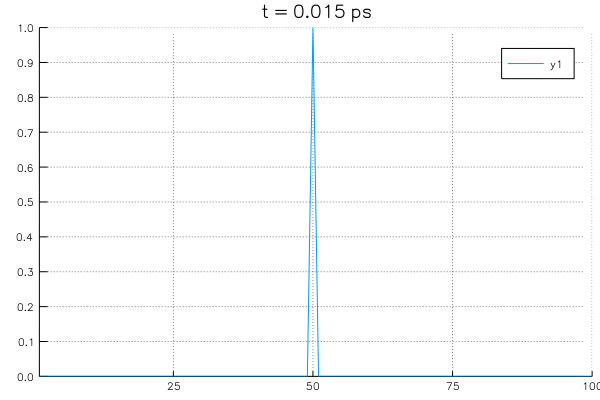
B. Solving diffusion equation with a potential profile.
\[
\begin{equation}
\frac{\partial \rho(x, t)}{\partial t}
= D \frac{\partial}{\partial x}[ \frac{\partial \rho(x, t)}{\partial x} + \frac{1}{k_BT} \frac{\partial U(x)}{\partial x}\rho(x,t)] = D \frac{\partial^2 \rho(x, t)}{\partial x^2} + \frac{D}{k_BT} \cdot U^{\prime}(x) \cdot \frac{\partial \rho(x, t)}{\partial x} + \frac{D}{k_BT} U^{\prime \prime}(x) \rho(x, t)
\end{equation}
\]
The finite difference in Crank-Nicolson scheme for the above equation is:
\[
\begin{align}
&\ \frac{\rho_{i,j + 1} - \rho_{i,j}}{\Delta t} = \frac{D}{2} ( \frac{\rho_{i+1,j} - 2\rho_{i,j} + \rho_{i-1,j}}{\Delta x^2} + \frac{\rho_{i + 1,j + 1} - 2\rho_{i,j + 1} + \rho_{i - 1,j + 1}}{\Delta x^2} ) + \frac{D \cdot U^{\prime}(x_i)}{2 k_BT} (\frac{\rho_{i + 1,j + 1} - \rho_{i - 1,j + 1}}{2 \Delta x} + \frac{\rho_{i + 1,j} - \rho_{i - 1, j}}{2 \Delta x}) + \frac{D \cdot U^{\prime \prime}(x_i)}{2 k_BT} (\rho_{i,j + 1} + \rho_{i,j}) \\
&\Rightarrow (2 + 2\lambda + \tau_i) \rho_{i,j + 1} + (\eta_i - \lambda)\rho_{i+1,j + 1} - (\lambda + \eta_i) \rho_{i-1, j + 1} = (2 - 2\lambda - \tau_i) \rho_{i,j} + (\lambda - \eta_i) \rho_{i+1,j} + (\lambda + \eta_i) \rho_{i-1, j}
\end{align}
\]
where \(\lambda=\frac{D \cdot \Delta t}{\Delta x^2}\), \(\eta_i = - \frac{D \cdot \Delta t}{2 k_BT \Delta x} \cdot U^{\prime}(x_i)\), \(\tau_i = - \frac{D \cdot \Delta t}{k_BT} \cdot U^{\prime \prime}(x_i)\).
Rewrite this in matrix form,
\[
\begin{equation}
A \vec{\rho}_{i, j + 1} - R = B \vec{\rho}_{i, j} + R
\end{equation}
\]
Supplemented by initial condition: \( \rho_{i,0} = \rho(x_i)\),
and Boundary conditions: \( \rho_{0,j} = \rho_0\), \( \rho_{m,j} = \rho_m\), we can solve it like this:

Solving an example system with initial value of \(\rho=1.0\) at \(x=30 \unicode{x212B}\) and boundary conditions with \(\rho_L = \rho_R = 0\) using the potential profile of \(n_w = 0\).
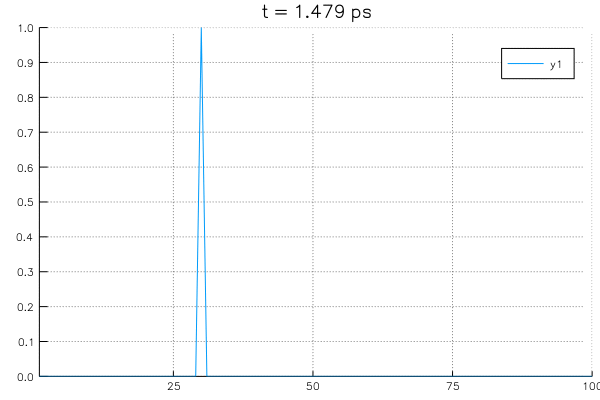
Potential used in this example and its derivatives are as follows:
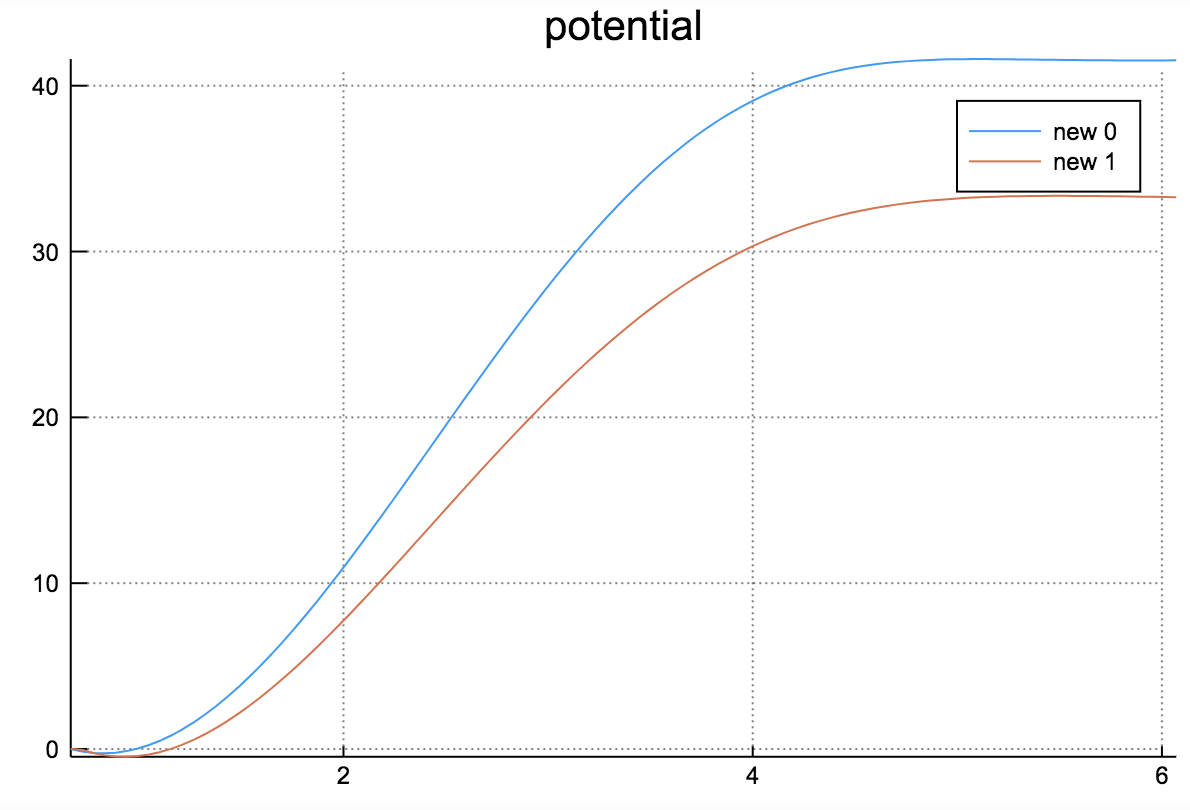
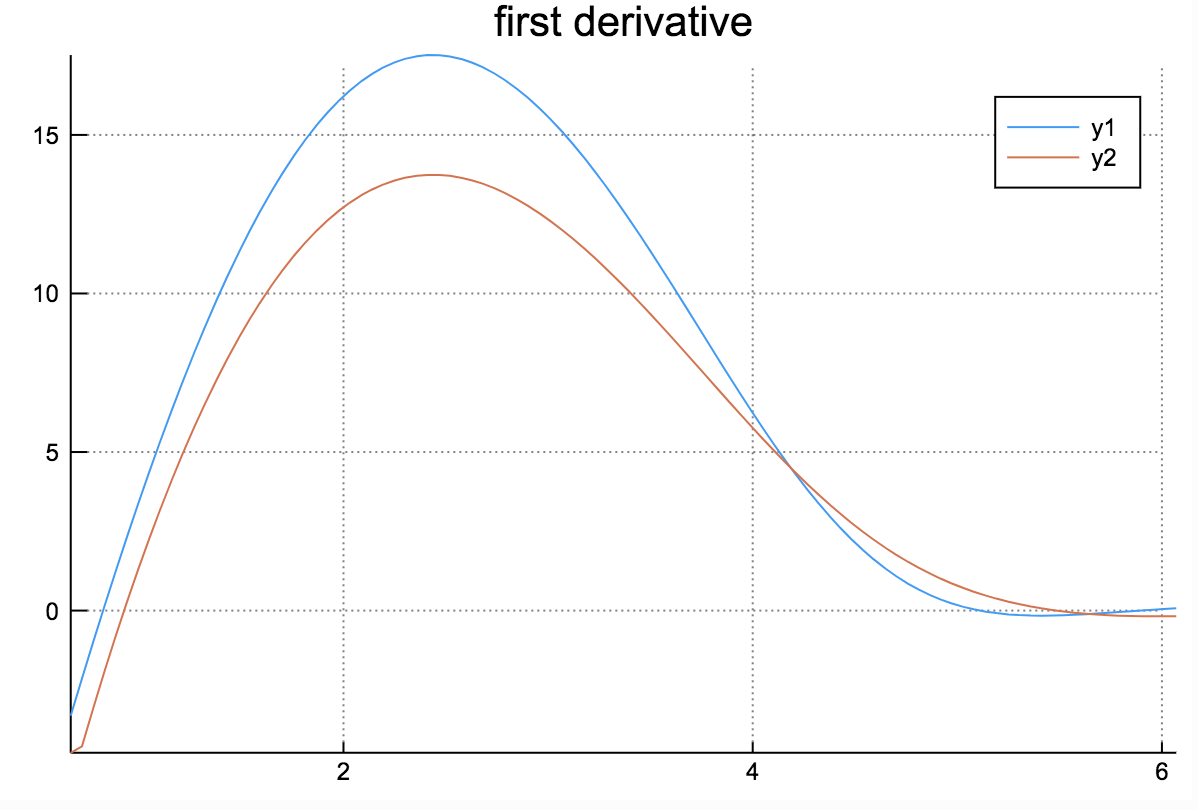
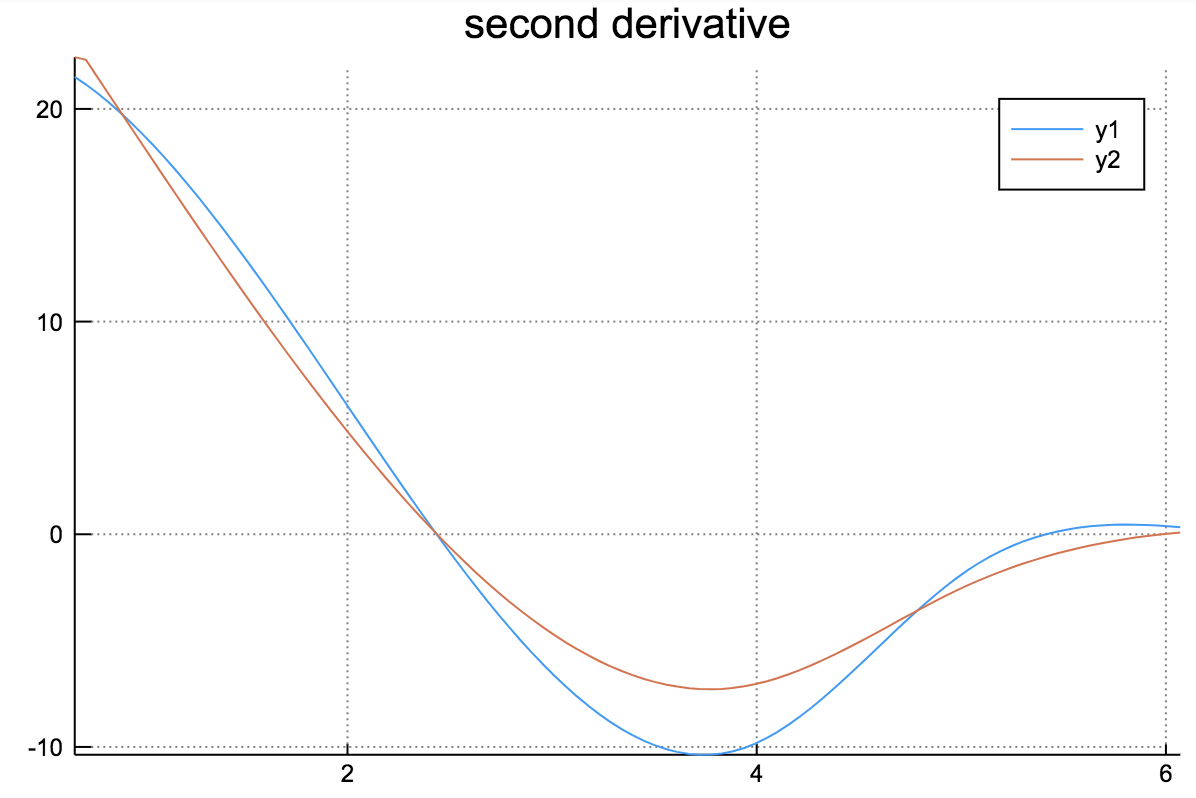
C. Solving coupled diffusion equations with potential profiles and reactions.
When reaction terms are added to the equation(16), equations corresponding to different \(n_w\) become coupled equations:
\[
\begin{equation}
\begin{cases}
\frac{\partial \rho_0(x, t)}{\partial t}
= D \frac{\partial}{\partial x}[ \frac{\partial \rho_0(x, t)}{\partial x} + \frac{1}{k_BT} \frac{\partial U_0(x)}{\partial x}\rho_0(x, t)] - [k_{0 \to 1} + k_0^{wf}(x)]\rho_0(x, t) + k_{1 \to 0}\rho_1(x, t) \\
\frac{\partial \rho_1(x, t)}{\partial t}
= D \frac{\partial}{\partial x}[ \frac{\partial \rho_1(x, t)}{\partial x} + \frac{1}{k_BT} \frac{\partial U_1(x)}{\partial x}\rho_1(x, t)] - [k_{1 \to 2} + k_{1 \to 0} + k_1^{wf}(x)]\rho_1(x, t) + k_{2 \to 1}\rho_2(x, t) + k_{0 \to 1}\rho_0(x, t) \\
\frac{\partial \rho_2(x, t)}{\partial t}
= D \frac{\partial}{\partial x}[ \frac{\partial \rho_2(x, t)}{\partial x} + \frac{1}{k_BT} \frac{\partial U_2(x)}{\partial x}\rho_2(x, t)] - [k_{2 \to 3} + k_{2 \to 1} + k_2^{wf}(x)]\rho_2(x, t) + k_{3 \to 2}\rho_3(x, t) + k_{1 \to 2}\rho_1(x, t) \\
\vdots \\
\vdots \\
\frac{\partial \rho_{n-1}(x, t)}{\partial t}
= D \frac{\partial}{\partial x}[ \frac{\partial \rho_{n-1}(x, t)}{\partial x} + \frac{1}{k_BT} \frac{\partial U_{n-1}(x)}{\partial x}\rho_{n-1}(x, t)] - [k_{n-1 \to n} + k_{n-1 \to n-2} + k_{n-1}^{wf}(x)]\rho_{n-1}(x, t) + k_{n \to n-1}\rho_n(x, t) + k_{n-2 \to n-1}\rho_{n-2}(x, t) \\
\frac{\partial \rho_n(x, t)}{\partial t}
= D \frac{\partial}{\partial x}[ \frac{\partial \rho_n(x, t)}{\partial x} + \frac{1}{k_BT} \frac{\partial U_n(x)}{\partial x}\rho_n(x, t)] - [k_{n \to n-1} + k_n^{wf}(x)]\rho_n(x, t) + k_{n-1 \to n}\rho_{n-1}(x, t)
\end{cases}
\end{equation}
\]
Let \(\rho_{i,j}^k = \rho_k(x_i,t_j)\), the finite difference in Crank-Nicolson scheme for \(n_w = k\) is:
\[
\begin{align}
&\ \frac{\rho_{i,j + 1}^k - \rho_{i,j}^k}{\Delta t} = \frac{D}{2} ( \frac{\rho_{i+1,j}^k - 2\rho_{i,j}^k + \rho_{i-1,j}}{\Delta x^2} + \frac{\rho_{i + 1,j + 1} - 2\rho_{i,j + 1} + \rho_{i - 1,j + 1}}{\Delta x^2} ) + \frac{D \cdot U_k^{\prime}(x_i)}{2 k_BT} (\frac{\rho_{i + 1,j + 1}^k - \rho_{i - 1,j + 1}^k}{2 \Delta x} + \frac{\rho_{i + 1,j}^k - \rho_{i - 1, j}^k}{2 \Delta x}) + \frac{D \cdot U_k^{\prime \prime}(x_i)}{2 k_BT} (\rho_{i,j + 1}^k + \rho_{i,j}^k) - \frac{k_{k \to k-1} + k_{k \to k+1} + k_k^{wf}(x_i)}{2} (\rho_{i,j+1}^k + \rho_{i,j}^k) + \frac{k_{k-1 \to k}}{2} (\rho_{i,j+1}^{k-1} + \rho_{i,j}^{k-1}) + \frac{k_{k+1 \to k}}{2} (\rho_{i,j+1}^{k+1} + \rho_{i,j}^{k+1})\\
&\Rightarrow (2 + 2\lambda + \tau_i^k) \rho_{i,j + 1}^k + (\eta_i - \lambda)\rho_{i+1,j + 1}^k - (\lambda + \eta_i^k) \rho_{i-1, j + 1}^k + \xi_i^k \rho_{i,j + 1}^k - \zeta^k \rho_{i,j + 1}^{k+1} - \kappa^k \rho_{i,j + 1}^{k-1} = (2 - 2\lambda - \tau_i^k) \rho_{i,j}^k + (\lambda - \eta_i^k) \rho_{i+1,j}^k + (\lambda + \eta_i^k) \rho_{i-1, j}^k - \xi_i^k \rho_{i,j + 1}^k + \zeta^k \rho_{i,j + 1}^{k+1} + \kappa^k \rho_{i,j + 1}^{k-1}
\end{align}
\]
where
\[
\begin{align}
&\lambda=\frac{D \cdot \Delta t}{\Delta x^2} \\
&\eta_i^k = - \frac{D \cdot \Delta t}{2 k_BT \Delta x} \cdot U_k^{\prime}(x_i) \\
&\tau_i^k = - \frac{D \cdot \Delta t}{k_BT} \cdot U_k^{\prime \prime}(x_i) \\
&\xi_i^k = (k_{k \to k+1} + k_{k \to k-1} + k_k^{wf}(x_i)) \Delta t \\
&\zeta^k = k_{k+1 \to k} \Delta t \\
&\kappa^k = k_{k-1 \to k} \Delta t
\end{align}
\]
We further define following \((m-1) \times (m-1)\) matrices:
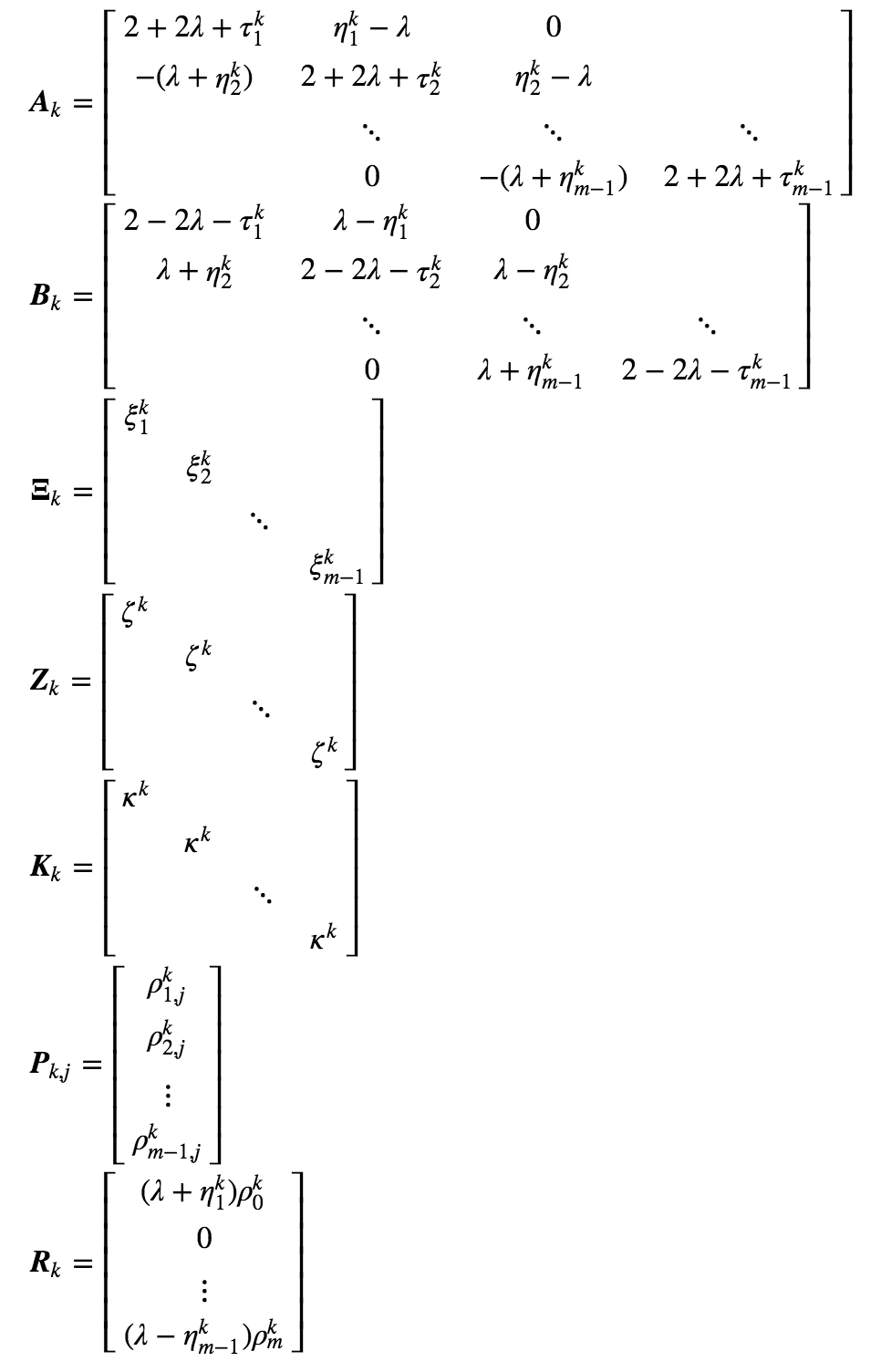
Rewrite in matrix form,

Solving an example system with initial value of \(\rho=1.0\) at \(x=40 \unicode{x212B}\) for all \(n_w=0:9\) and boundary conditions with \(\rho_L = \rho_R = 0\) using the potential profile of \(n_w = 0\).
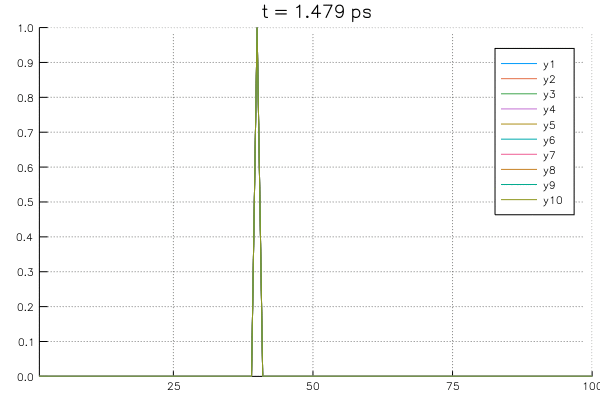
The above example calculations are produced using Julia 6.0 with matplotlib. You can find the example jupyter notebook file HERE.